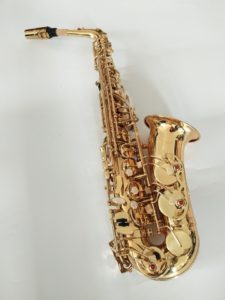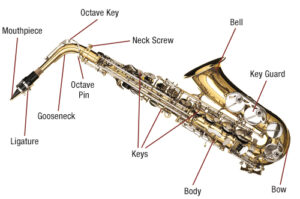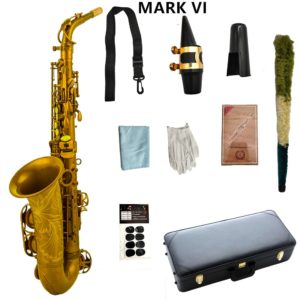The Complete Guide to the Alto Saxophone in Eb
Listen to the Audio “The Complete Guide to the Alto Saxophone in Eb”
 Are you a music enthusiast looking to explore the world of wind instruments? Look no further than the alto saxophone in Eb! Known for its soulful and expressive sound, the alto saxophone has been a staple in jazz, classical, and popular music for decades.
Are you a music enthusiast looking to explore the world of wind instruments? Look no further than the alto saxophone in Eb! Known for its soulful and expressive sound, the alto saxophone has been a staple in jazz, classical, and popular music for decades.
Whether you’re a beginner or an experienced player, this complete guide is designed to provide you with everything you need to know about this versatile instrument. From its history and construction to tips on technique and maintenance, we’ve got you covered.
Discover the different types of alto saxophones, learn how to assemble and care for your instrument, and explore various playing techniques that will help you achieve a rich and vibrant tone.
So, grab your saxophone and let’s dive into the world of the alto saxophone in Eb!
History and Development of the Alto Saxophone
The alto saxophone was invented by Belgian instrument maker Adolphe Sax in the 1840s. Adolphe Sax sought to create an instrument that combined the power of a brass instrument with the agility of a woodwind instrument. The result was the saxophone family, which includes the alto saxophone, along with other sizes such as the soprano, tenor, and baritone saxophones.
The alto saxophone quickly gained popularity in military bands and orchestras. Its unique sound and versatility made it a favourite among composers such as Hector Berlioz and Georges Bizet. In the early 20th century, the alto saxophone found a new home in jazz music, where it became an essential part of the genre’s signature sound.
Over the years, the alto saxophone has undergone several improvements in design and keywork. Modern alto saxophones are made from brass and feature a curved neck, a body with keys and tone holes, and a detachable mouthpiece. The instrument is typically tuned to the key of Eb, which gives it a bright and vibrant sound.
Parts of the Alto Saxophone
 To fully understand how the alto saxophone works, it’s important to familiarize yourself with its various parts. The alto saxophone consists of several key components, each playing a crucial role in producing sound.
To fully understand how the alto saxophone works, it’s important to familiarize yourself with its various parts. The alto saxophone consists of several key components, each playing a crucial role in producing sound.
- Body: The body of the alto saxophone is made from brass and is usually lacquered or plated to protect the metal. It houses the keys and tone holes that control the pitch and tone of the instrument.
- Neck: The neck of the alto saxophone is a curved piece that connects the body to the mouthpiece. It helps to create a more comfortable playing position and also affects the overall tone of the instrument.
- Mouthpiece: The mouthpiece is where the player blows air into the saxophone. It consists of a metal ligature, a reed, and a facing, which is the curved part that touches the reed.
- Keys: The keys of the alto saxophone are used to cover and uncover the tone holes, thereby changing the pitch of the notes. They are typically made from brass or nickel silver and are padded to create a seal when pressed down.
- Bell: The bell of the alto saxophone is the flared end of the instrument. It helps to project the sound and adds resonance to the overall tone.
How to Assemble and Disassemble the Alto Saxophone
Assembling and disassembling the alto saxophone is a simple process that can be done with a few easy steps. Proper assembly is crucial for ensuring that the instrument functions correctly and produces the desired sound.
To assemble the alto saxophone, follow these steps:
- Start by attaching the neck to the body of the saxophone. The neck should fit securely into the receiver on the body.
- Next, insert the mouthpiece onto the neck. The ligature should be tightened securely around the reed to hold it in place.
- Attach the neck strap to the saxophone. The strap should be adjusted so that the saxophone rests comfortably around your neck while allowing your hands to reach the keys.
- Finally, check that all the keys are in the closed position and that the instrument is properly aligned. Make any necessary adjustments before playing.
To disassemble the alto saxophone, follow these steps:
- Start by removing the mouthpiece from the neck. Loosen the ligature and gently slide the mouthpiece off.
- Detach the neck strap from the saxophone.
- Carefully remove the neck from the body of the saxophone.
- Clean and dry all the parts before storing them in a protective case.
Remember to handle the saxophone with care during assembly and disassembly to avoid damaging any of the delicate components.
Choosing the Right Mouthpiece for the Alto Saxophone
 The mouthpiece is a critical component of the alto saxophone that greatly affects the tone and playability of the instrument. Choosing the right mouthpiece can make a significant difference in your overall saxophone experience.
The mouthpiece is a critical component of the alto saxophone that greatly affects the tone and playability of the instrument. Choosing the right mouthpiece can make a significant difference in your overall saxophone experience.
When selecting a mouthpiece for your alto saxophone, consider the following factors:
- Tip Opening: The tip opening refers to the distance between the reed and the mouthpiece facing. A larger tip opening produces a brighter and more projecting sound, while a smaller tip opening produces a darker and more focused sound.
- Facing Length: The facing length refers to the curve of the mouthpiece facing. A longer facing length generally provides more resistance and control, while a shorter facing length offers greater flexibility and ease of playing.
- Material: Mouthpieces are typically made from hard rubber or metal. Hard rubber mouthpieces are favoured for their warm and rich tone, while metal mouthpieces are known for their bright and edgy sound.
- Brand and Model: Different brands and models of mouthpieces can have distinct characteristics and sound qualities. It’s important to try out different mouthpieces and find one that suits your playing style and preferences.
When trying out mouthpieces, take the time to play different notes and explore the instrument’s full range. Pay attention to how the mouthpiece responds to your embouchure and breathing, and listen for the tone and projection that you desire. Ultimately, the right mouthpiece is the one that allows you to express yourself fully on the alto saxophone.
Proper Embouchure and Breathing Techniques
Achieving a good embouchure and mastering proper breathing techniques are essential for producing a beautiful and controlled sound on the alto saxophone. Here are some tips to help you develop a strong foundation in embouchure and breathing:
- Embouchure: The embouchure refers to the way you position your lips, jaw, and facial muscles around the mouthpiece. A proper embouchure allows for good control and stability while playing.
- Place the mouthpiece on your bottom lip, slightly off-centre.
- Form a firm but flexible seal around the mouthpiece with your lips.
- Roll in your bottom lip slightly to create a cushion for the reed.
- Apply gentle pressure to the reed with your bottom lip, using your jaw and facial muscles to support the embouchure.
- Breathing: Proper breathing is essential for producing a full and resonant sound on the alto saxophone. Focus on diaphragmatic breathing and practice the following techniques:
- Stand or sit up straight with good posture.
- Take deep breaths, expanding your diaphragm and filling your lungs with air.
- Use your abdominal muscles to control the flow of air as you exhale.
- Maintain a steady stream of air while playing, avoiding short and shallow breaths.
- Practice long tones and exercises that focus on sustaining a steady and even sound.
Developing a strong embouchure and mastering proper breathing techniques takes time and practice. Start with simple exercises and gradually increase the difficulty as your skills improve. Remember to be patient with yourself and always strive for a relaxed and natural approach to playing the alto saxophone.
Fingerings and Basic Scales for the Alto Saxophone
Learning the fingerings and basic scales for the alto saxophone is crucial for developing your playing technique and musicality. Here are some essential fingerings and scales to get you started:
- Fingerings: The alto saxophone uses a system of keys and tone holes to produce different pitches. Here are the fingerings for the basic notes:
- Low Bb: Press the first three fingers of your left hand on the top three tone holes, and the first three fingers of your right hand on the bottom three tone holes.
- C: Lift the first finger of your left hand while keeping the other fingers in place.
- D: Lift the second finger of your left hand while keeping the other fingers in place.
- E: Lift the third finger of your left hand while keeping the other fingers in place.
- F: Lift the first finger of your right hand while keeping the other fingers in place.
- G: Lift the second finger of your right hand while keeping the other fingers in place.
- A: Lift the third finger of your right hand while keeping the other fingers in place.
- High Bb: Press the first three fingers of your left hand on the top three tone holes, and the first two fingers of your right hand on the bottom two tone holes.
- Basic Scales: Practicing scales is essential for developing your technique and understanding of music theory. Here are some common scales for the alto saxophone:
– C Major: C, D, E, F, G, A, B, C
– G Major: G, A, B, C, D, E, F#, G
– D Major: D, E, F#, G, A, B, C#, D
– A Major: A, B, C#, D, E, F#, G#, A
– E Major: E, F#, G#, A, B, C#, D#, E
Practice these scales in different rhythms and articulations to improve your finger dexterity and overall technique. As you progress, you can explore more advanced scales and modes to expand your musical vocabulary.
Common Beginner Mistakes and How to Avoid Them
As a beginner saxophonist, it’s common to make certain mistakes that can hinder your progress and development. Here are some common beginner mistakes and tips on how to avoid them:
- Poor Posture: Playing the saxophone requires good posture to ensure proper breathing and technique. Avoid slouching or leaning over the instrument and maintain an upright position.
- Squeaking or Honking Sounds: Squeaking or honking sounds are often caused by improper embouchure or insufficient air support. Focus on creating a firm but flexible embouchure and practice diaphragmatic breathing techniques.
- Inconsistent Tone: Inconsistent tone can result from uneven finger pressure or improper breath control. Pay attention to your finger placement and use a steady stream of air while playing.
- Neglecting Maintenance: Proper maintenance is essential for keeping your alto saxophone in good playing condition. Clean the instrument regularly, oil the keys as needed, and store it in a protective case when not in use.
- Lack of Practice Routine: Consistent practice is key to improving your skills on the alto saxophone. Set aside dedicated practice time each day and establish a routine that focuses on different aspects of playing, such as technique, scales, and repertoire.
By being aware of these common beginner mistakes and taking proactive steps to address them, you can accelerate your progress and achieve better results on the alto saxophone.
Intermediate and Advanced Techniques for the Alto Saxophone
Once you have a solid foundation in the basics, you can begin exploring intermediate and advanced techniques to further expand your musicality and expressiveness on the alto saxophone. Here are some techniques to work on:
- Vibrato: Vibrato is a technique used to add warmth and expression to your playing. It involves oscillating the pitch of a note by slightly altering the embouchure and air pressure. Practice adding controlled vibrato to sustained notes to develop this skill.
- Articulation: Articulation refers to how you start and end each note. Experiment with different tonguing techniques, such as single tonguing, double tonguing, and triple tonguing, to achieve different articulation effects.
- Extended Techniques: Explore extended techniques, such as multiphonics, altissimo register, and growling, to add unique sounds and effects to your playing. These techniques require experimentation and practice to master.
- Improvisation: Improvisation is a fundamental skill in jazz and other genres. Start by learning basic jazz scales and chord progressions, and gradually develop your ability to spontaneously create melodies and solos.
- Expression and Dynamics: Work on your ability to convey emotion and vary the dynamics in your playing. Experiment with different phrasing, dynamics, and articulation to bring out the musicality in your performances.
Remember to approach intermediate and advanced techniques with patience and persistence. Take the time to practice each technique slowly and gradually increase the tempo as you become more comfortable. Seek guidance from experienced saxophonists or take lessons to further refine your skills.
Maintenance and Care for the Alto Saxophone
Proper maintenance and care are essential for keeping your alto saxophone in optimal playing condition and extending its lifespan. Here are some tips to help you maintain and care for your instrument:
- Cleaning: Regularly clean the inside and outside of your saxophone using a soft cloth or a specially designed cleaning swab. Remove moisture from the tone holes and keys after playing to prevent build-up.
- Oiling: Apply a small amount of key oil to the pivot points and rods of the keys to ensure smooth and silent key action. Avoid using excessive oil, as it can attract dirt and debris.
- Pad Care: Inspect the saxophone pads regularly for wear and tear. Replace damaged or worn pads to maintain proper sealing and intonation. Avoid touching the pads with your fingers, as oils from your skin can cause damage.
- Storage: Store your saxophone in a protective case when not in use to protect it from dust, moisture, and other environmental factors. Keep the case in a cool and dry place, away from direct sunlight or extreme temperatures.
- Professional Servicing: Schedule regular check-ups with a qualified instrument technician to ensure that your saxophone is in optimal playing condition. A professional technician can identify and address any potential issues before they become major problems.
By incorporating proper maintenance and care, you will get a lot of enjoyment playing your Alto Saxophone.
Conclusion to the Alto Saxophone in Eb
 An alto saxophone is a woodwind instrument which belongs to the saxophone family. The alto saxophone in Eb is a difficult instrument to play and requires a lot of practice. The output of this woodwind instrument is low-pitched. Moreover, it has a smooth sound and is used in jazz groups for solo performances. To learn to play the alto saxophone first, you have to be able to read musical tables for the pitch degree corresponding to each note. You can also learn from a teacher who can help you in the right techniques for playing the music.
An alto saxophone is a woodwind instrument which belongs to the saxophone family. The alto saxophone in Eb is a difficult instrument to play and requires a lot of practice. The output of this woodwind instrument is low-pitched. Moreover, it has a smooth sound and is used in jazz groups for solo performances. To learn to play the alto saxophone first, you have to be able to read musical tables for the pitch degree corresponding to each note. You can also learn from a teacher who can help you in the right techniques for playing the music.
